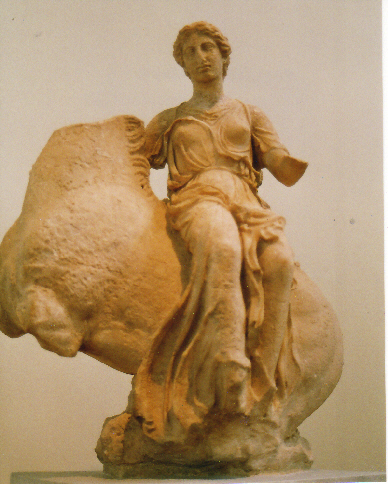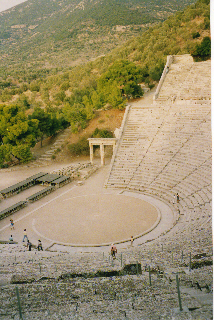Epídavros, set in a quiet
wooded valley in the Argolis, was famous in the
Greek world and beyond as a sanctuary of
the healing god Asklepios, son of Apollo.
The sanctuary was much endowed by wealthy
visitors and hosted a drama festival every four
years in the theatre which was considered
the most beautiful in the world. It is today
the best preserved Greek theatre and is a quite
simply breathtaking sight. Constructed in the 3rd
century BC in a pure and classical style,
it originally seated 6,000 people in 34 rows; in
the 2nd century 24 rows were added to seat a
further 6,000. As usual there are moulded seats
at the front for the VIPs. The entrances, skene
and proskene are preserved.
The acoustics are remarkable: climb to the top of
the 54 tiers of seats and you will hear the
rustle of paper or a coin dropped by someone
standing in the centre of the circular orchestra
below, (the only intact surviving one)
Be prepared to do your party piece!
Games held at the
sanctuary were almost on a level with those at
Olympia and Delphi. The architecture and
sculpture were extremely rich, but with a slight
heaviness that marks the end of the Classical
period. Of the late 5th century BC temple of
Asklepios itself, and of the elaborate
tholos or rotunda built in the 4th C, only
the foundations and some fragments remain.
(Although it is currently being restored).
The site has been heavily
cannibalised especially in the Byzantine period -
fragments have been found built into churches in
the area. The ancient roads that connected
the sanctuary with the city can still be traced.
The ruins themselves, apart from the theatre, are
confusing.
The small museum is
very interesting. The reconstructions give a
clear impression of the former beauty and
richness of the buildings. There is also an
excellent example of a Corinthian capital.
go back to home page
|

Neriad
from the temple of Asklepios (in the National
Archaeological Museum, Athens)
|

